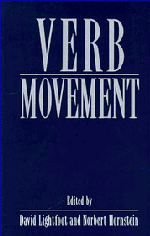Book contents
- Frontmatter
- Contents
- List of contributors
- Preface
- Verb movement: an introduction
- 1 Verb positions: evidence from Italian
- 2 Verb movement and word order in Arabic
- 3 Comments on the paper by Ouhalla
- 4 Some similarities and differences between Icelandic and Yiddish
- 5 Comments on the paper by Santorini
- 6 Finite verb movement in Scandinavian embedded clauses
- 7 Comments on the paper by Vikner
- 8 The Brythonic copula and head raising
- 9 A reinterpretation of evidence for verb movement in French
- 10 Two types of head movement in Romance
- 11 Comments on the paper by Roberts
- 12 Licensing heads
- 13 Comments on the paper by Koopman
- 14 Finiteness and head movement in early child grammars
- 15 Comments on the paper by Wexler
- References
- Index
4 - Some similarities and differences between Icelandic and Yiddish
Published online by Cambridge University Press: 03 May 2011
- Frontmatter
- Contents
- List of contributors
- Preface
- Verb movement: an introduction
- 1 Verb positions: evidence from Italian
- 2 Verb movement and word order in Arabic
- 3 Comments on the paper by Ouhalla
- 4 Some similarities and differences between Icelandic and Yiddish
- 5 Comments on the paper by Santorini
- 6 Finite verb movement in Scandinavian embedded clauses
- 7 Comments on the paper by Vikner
- 8 The Brythonic copula and head raising
- 9 A reinterpretation of evidence for verb movement in French
- 10 Two types of head movement in Romance
- 11 Comments on the paper by Roberts
- 12 Licensing heads
- 13 Comments on the paper by Koopman
- 14 Finiteness and head movement in early child grammars
- 15 Comments on the paper by Wexler
- References
- Index
Summary
Introduction
Among the Germanic languages, Icelandic and Yiddish are only distantly related and have had virtually no contact, yet they share a striking number of important (morpho) syntactic properties: head-initial phrase structure, rich subject-verb agreement, overt case morphology on full noun phrases, the availability of empty expletive subjects, and the productive use of verb-first declarative clauses in narrative contexts. Both languages also exhibit the verb-second (V2) phenomenon—not only in root clauses, but in subordinate clauses as well. While the similarities between Icelandic and Yiddish have been the subject of some discussion in the literature (Platzack & Holmberg 1990, Santorini 1989, Sigur∂sson 1990a, Vikner 1991), less attention has been paid to the differences between them. In this paper, I attempt to right this balance by focusing on these differences.
The paper is organized as follows. Section 2 sets the stage for the discussion of the differences between the grammars of Icelandic and Yiddish by reviewing an important similarity between them: the productivity of embedded V2. Following much recent work, my analysis of this shared property relies on the VP-Internal Subject Hypothesis, according to which subjects originate in a position dominated by a maximal projection of the verb. The remainder of the paper is devoted to differences between the two languages. Section 3 shows that although empty expletives are licensed in both Icelandic and Yiddish, their distribution is not identical: empty expletives can occupy Spec of IP in Icelandic, whereas they are barred from this position in Yiddish.
- Type
- Chapter
- Information
- Verb Movement , pp. 87 - 106Publisher: Cambridge University PressPrint publication year: 1994
- 5
- Cited by



